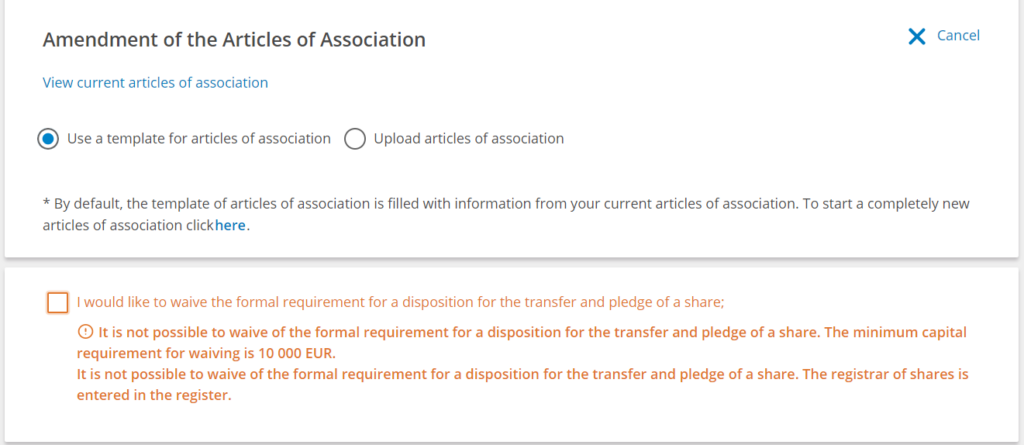

Almost every aspect of establishing and managing an Estonian company can be done entirely online from anywhere. We say almost because things get a bit tricky when you want to add a shareholder to your private limited company. Adding a new director is already very easy if that person is an e-resident who can make a digital signature.
Until now, you’d have to transfer shares offline at a notary in Estonia. There are also two novel ways to transfer shares in an Estonian company, but these methods both have limitations too. Fortunately, there’s also a little-known trick that enables you to add a new shareholder online for your Estonian limited company without having to transfer any existing shares at all. The new shareholders don’t even need to have an Estonian digital ID.
So we put together this up-to-date guide with everything you need to know about how to add a new shareholder for an Estonian limited company.
The standard ways to add a shareholder to your limited company
If you want to bring in a new co-owner then most Estonian company owners, until now, have had to arrange offline notary appointments to transfer shares. That needs to be done in Estonia with all shareholders present, which comes with both hassle and cost. It’s inconvenient even if you live in Estonia at the best of times, but it’s especially inconvenient for e-residents and during a lockdown.
If a shareholder can’t attend the notary meeting, the only alternative has been through the use of ‘power of attorney’. This will save a trip to a notary in Estonia, but it’s still just another layer of hassle and expense to involve a business services provider, in addition to a notary. You’ll probably need to pay for a foreign notary too because documents from most countries will need to be apostilled by the designated authority.
The notary fees in Estonia are regulated by law and are quite low for small share transfers, but this also means that Estonian notaries do not want to perform these cheap transactions with foreigners. This means that you could wait a month to get an appointment.
Why was it so tricky to transfer shares for an Estonian company?
Estonia is proud to be a digital nation where 99% of government services are online and everyone has a digital ID that can be used for authenticating themselves and signing legal agreements online. However, some big decisions must still be made offline. That covers getting married, getting divorced, buying property, selling property, buying company shares, and selling company shares.
This isn’t because Estonia lacks the technology for these things to be done online. It’s simply that these are such big decisions that the state wants to be sure you are doing them of your own free will after serious consideration. It probably wouldn’t be a good idea if you could just hit delete on your marriage at any time of the day or night. When it comes to transferring shares and real estate, the state wants an extra layer of security to prevent you from being blackmailed or unduly pressured to sign off assets. By law, a notary is an independent public official to whom the Estonian state has delegated this duty to oversee the security of legal relationships and the prevention of legal disputes. A notary always has mandatory professional indemnity insurance to compensate for any damage caused by wrongful transactions.
You might think voting should fall into that category too, but Estonia’s e-voting system already has some well-thought-out safeguards designed into it, such as the ability to vote repeatedly whenever you want to change your last ballot.
You used to have to register your baby offline too if you were an unmarried couple, but this coronavirus crisis has at least swept away that requirement. It’s an example of how this crisis is acting as a catalyst for even deeper digitisation, even in Estonia where things are already very advanced. You may have seen in the news, for example, that Unicount has joined forces with other companies in Estonia serving e-residents to formally request that the Estonian government prioritise the elimination of offline pickups for e-Residency digital ID cards. That story is here in Estonian. So we hope that urgent advances in digitisation during this crisis could be extended to the area of buying and selling company shares too.
However, there are already four alternative options you can consider for adding a new shareholder to a limited company.
Just before the crisis, the Estonian notaries helpfully added a new way to sell shares of your Estonian company. In addition, the law has been changed to allow one new method that can be used in two different ways. Finally, we at Unicount have discovered our own very simple solution.
Four alternative ways of adding new shareholders to a limited company
1. Using an e-notary
Estonian notaries have launched an e-notary service so that e-residents can transfer shares to another e-resident online, instead of at a notary office in Estonia. You can read more about this on the e-Residency blog here.
All other aspects of the process remain the same so you will still need to book and pay for a notary, but at least you don’t have to fly to Estonia or get an attorney involved.
You can choose a notary by logging in with your digital ID at notar.ee. Don’t worry too much about which one to choose, as long as they can conduct the transaction in English and are happy to use an e-notary. Notary fees are regulated by law and they all provide the same good quality of service.
You would need a good internet connection for video streaming and a web camera for biometric facial recognition by Estonian verification startup Veriff. So this will help all e-residents around the world, but not everyone. Getting an appointment may be problematic if you are in a hurry.
2. Managing your shareholder list
The Estonian Parliament recently changed the law at the request of the startup sector so that shares can now be transferred to a new shareholder at the responsibility of the parties involved if the company’s articles of association approve this. This can only be added to the articles of association if it is unanimously agreed by all existing shareholders.
The law came into force on 1 August 2020.
However, for this to work your company will need to have a share capital of at least €10,000 that has been fully paid and registered before you waive the requirement for a notary. That helps grow startups, but is not useful for most e-residents and other Estonian company owners.

This is similar to the historical trust-based system already used in other EU jurisdictions, such as the UK and Sweden. The Estonian version is safer though as unauthorized people cannot send fake hand-signed paper documents to the register. All is done online with a clear track record of the steps taken by the management board. Updating the shareholder list on the register is free.
However, what if you don’t have a share capital of €10,000 paid in, but still want to add a shareholder to a limited company?
3. Using NASDAQ CSD
Your company can register its shares with Nasdaq CSD, as an alternative to the Estonian Business Register managing your shareholder list. The monthly fee for the maintenance of shares worth up to 80,000 euros in nominal value would be 10 euros plus VAT per calendar quarter. There are also some minor registration fees when switching to CSD service.
Nasdaq CSD is the regional central securities depository (CSD) with a business presence in Estonia, Iceland, Latvia and Lithuania. They manage the shareholder lists of listed stock companies and other companies wishing to use their services.
The restriction here though is that all the shareholders need to have a securities account at an Estonian bank. That can be a tricky requirement for even the most experienced venture capital fund investors if they are non-residents. It also still requires a trip to Estonia to open the initial account at that bank before applying for the securities account. Estonian startups have lobbied to change this requirement, but have had no success so far.
So what if your new shareholder doesn’t have an Estonian securities account and none of the other options are suitable for you? Well, there is one more option that we’ve discovered.
4. The simplest way to add shareholders for your limited company
There’s one more way to add a new shareholder to your Estonian company and it’s surprisingly simple. We like to keep things simple here at Unicount so we’ve done it ourselves multiple times with our own businesses and we are aware that it is the standard way for Estonian startups to raise capital.
It works because you don’t actually transfer any existing shares to your new shareholder. You simply issue new shares online directly to them instead. This involves no notary and no attorney.
As outlined in Estonia’s Commercial Code, you will need to produce a digitally signed shareholders’ resolution that outlines the planned new share allocation with the details of all the shareholders. You do not need proof of their payment of up to €50 000 from your company’s banking service provider. Please note that the added shareholders should not make the payments before the shareholder resolution gets signed, as some registry department clerks may find it to be a wrong sequence of events. The proof for payment over that threshold should be a digitally signed deposit certificate as described in our article “How to register share capital of your Estonian company“. Also, you cannot issue any new shares before your minimum share capital of 2,500 euros is paid up and registered as described in the linked article.
If your articles of association specify an exact registered share capital amount (as is in standard articles) then you might want to make this more flexible, such as ‘€2,500 to €10,000’. This will enable you to repeat this share-issuing process again in future by adding a new shareholder without having to submit the changed articles to the Business Register too. Two important legal requirements to note are that your minimum capital should be in a ratio of 1⁄4 to maximum share capital and some court clerks have started demanding that share premium (also called agio) needs to be allowed by company articles if your new shareholders pay anything above share nominal value.
Premium is very useful when you value your company above the nominal value of your share and the new shareholder also agrees to pay more than the nominal value of the new share issued. Anything above the nominal (face) value would be treated as a premium instead of the registered share capital. This is very handy if your company is a startup with losses that have reduced the company equity below the registered share capital. So just bear in mind that this would not help you when you just want to sell your shares for profit as the premium would stay in the company as equity.
For example, let’s say you are the sole shareholder of a company with a minimum share capital of €2,500 and you want to sell 20% of your company to a new partner. You don’t need to transfer 20% of your share. Instead, you can decide to issue a new share with a nominal value of 625 euros and mark your business partner as the new shareholder. After you have digitally signed the shareholder resolution that person/company will then make their payment of the required nominal or nominal plus premium amount into your business account before you can register the new shareholder with Business Register.
You can then log into the e-Business Register, alter the share capital amount and shareholders list, and submit it with shareholder resolution and bank certificates. This is then processed by the Tartu County Court registration department which will check that this process has been done correctly and update the public data in the Business Register to make it official.
Here’s an interesting thing about this method. Only the existing shareholders need to digitally sign the shareholder resolution. Unlike selling shares at a notary, the court does not expect people who have been issued new shares to present any written consent, representation right documents or notarised registration certificates for legal persons becoming your shareholders.
That means you can add a shareholder to your limited company even if they do not have an Estonian digital ID. The new partners would only need to make a digital signature on future shareholder resolutions if required under the rules of the company’s articles of association or Commercial Code and subject to the amount of their nominal shareholding. For example, amending the standard articles of association usually requires approval from two-thirds of shareholders so two 50% of shareholders would need to have digital ID cards for that. The annual report just has to be signed off by one director (member of the board) though. Even if a digital ID card isn’t needed, we’d always advise non-resident shareholders to apply for e-Residency for its long-term benefits, especially if you are going to be a substantial co-owner of an Estonian company, but at least you wouldn’t be held back by waiting to get your e-resident card.
Just one last issue…
There’s one thing that can make this advice a bit tricky for e-residents. The Estonian Business Register and the Tartu County Court Registration Department both expect your documents in Estonian.
So, since publishing this article, we’ve written up a free template for you to use. It’s in Estonian but has guidance in English about how to use it. You can download it here. If you would like to get some help from Unicount contact us and we will organize the process for a fee subject to an hourly rate.
What if I want to buy or sell an entire Estonian company?
Finally, this subject also comes up a lot in the e-resident community as people seek to buy Estonian companies. Our advice is simple here too: Don’t.
The main motive for buying an existing company among e-residents is to get hold of an existing bank account or licence that the company may have too, such as a licence to trade crypto. This isn’t advisable because both of those things are issued to the company dependent on factors that include an assessment of the business model, clients, shareholders, beneficial owners and board members. If any of these details change then both the bank account and license can be withdrawn (as often happens in these circumstances).
Fortunately, it’s so simple to set up a limited company online that there is little to be gained from trying to buy one from someone else. You can then apply for banking and licenses that are available based on your circumstances.
Selling your dormant company can be an alternative to liquidation, which is a cumbersome and expensive process in Estonia. Your main problem would be finding a buyer who would agree to take over your company based on your statements. It is a risk for the buyer clearly so you cannot expect to get any profit, but you may get your formation fees back at best.
Thanks for reading
Unicount is the simplest way to register a paperless EU company in Estonia, whether you are a citizen, resident or e-resident of Estonia.
Our service is available for people setting up a company with a single shareholder and director due to API limits from the Estonian Business Register. If you want to add a shareholder to a limited company, we recommend that you use the e-Business Register. However, you’d still need a registered office address and contact person so you can first sign up for Unicount’s virtual office subscription here then follow this guide for using Unicount’s address and contact person when registering a company through the e-Business Register.
But if you register a single shareholder company through Unicount then we hope this article has been useful if you later decide to add a shareholder online. Feel free to send us any feedback, either by opening the live chat on unicount.eu or by commenting where you saw this on social media.






